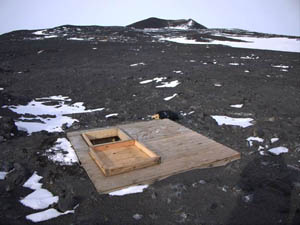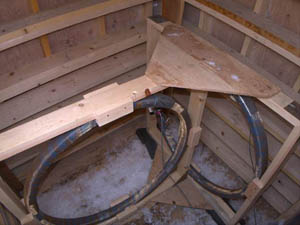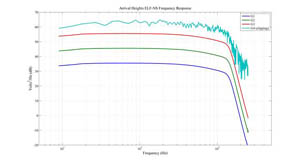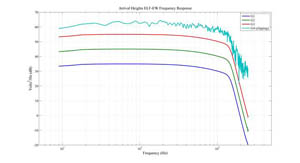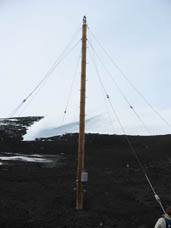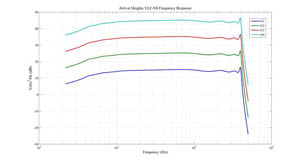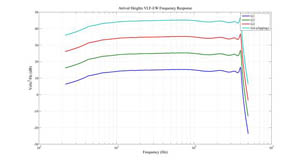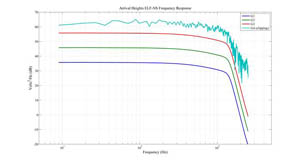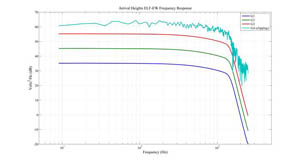McMurdo/South Pole Field Report 2012
23 December 2012 – 28 December 2012
ABSTRACT
During the shortened December 2012 deployment to Arrival Heights, Michael Mitchell and Dr. Robert Moore achieved all goals except for one, and that goal was completed during redeployment from South Pole. Cables were rearranged, the Trabucco Box was successfully modified, and the 4-AWG VLF antennas were replaced with 6-AWG antennas. It appears that the system performance was significantly improved by this antenna change. Pre- and post-hardware change calibrations were performed for both ELF and VLF systems. Double-copies of data exist: one copy is set aside at Arrival Heights, and the other copy will be coming back to Florida with us during our return trip. The high-speed E-SATA RAID tower was sent to South Pole by mistake. It arrived at McMurdo during our South Pole deployment. We replaced the USB RAID tower with the high-speed E-SATA RAID tower on 5 January 2013, upon returning to McMurdo from South Pole.
NOTE: Even after the hardware changes, the Trabucco Box is still causing problems with the ELF system: on occasion, the ELF signals are snowed out. The snow disappears after power cycling the Trabucco Box a few times. The microchips used in the Trabucco Box are out-of-print. We must fully replace this unit with updated electronics next season.
We departed from Gainesville Regional Airport (GNV) on 16 December 2012 and arrived at Christchurch, New Zealand (CHC) on 18 December 2012, accounting for the date change (~36 hours of travel).
We were scheduled to leave CHC on 20 December 2012, but our flight was delayed 3 days. The reasons for the delays are as yet unclear because the weather was good in Antarctica and in New Zealand almost all of the time. Apparently, the ice runway at McMurdo is too slushy to support take-offs. We arrived at McMurdo Station on 23 December 2012. We were scheduled to leave for South Pole on 28 December 2012, but our flight was cancelled, not due to weather, but because it was a backup flight and the other flight was successful. Instead, we left for South Pole on 29 December 2012.
DAY 1 (Sunday, 23 December 2012)
Upon arriving at McMurdo Station, we went through the initial general in-brief. At the end of the in-brief, we were awarded keys to our bedroom and passkeys to Crary Lab. We then went to the Science in-brief, where the most important thing we were told was that Shuttle Taxi service was no longer available due to budget cuts. We were also told that we would not be able to take truck-driving training courses until 26 December 2012, due to the Christmas holiday. Bill Bristow (UAF) was also there, and his point-of-contact (POC) set him up with a quick truck-driving training course, so we went with him. Taking this training meant that we were allowed to drive trucks, should one be available to us. We then arranged to borrow a shuttle for two days over the Christmas break because shuttle service to Pegasus would not be operating (shuttles were available). So we scored a van for two days. After the first two days, we signed out trucks from VMF each day, and had no problem keeping them signed out for the entire day. As a result, we had easy access to Arrival Heights throughout our site visit. I guess this is a positive thing, but I would have assumed this to be the case from the beginning. It is not.
Following this mini-adventure, we immediately went to Crary Lab, where we tracked down the Research Associate (Liz) and asked her to print us copies of the permit to enter the Arrival Heights ASPA. She was on her way out, so it was good that we took care of this right away. We then met with Crary Science Support Staff and got the keys to our office. We then immediately went to Crary IT Support Staff and got our Crary Network accounts. We then retrieved our bedding, set up our bedroom, and ate lunch. We met with Cara Sucher (POC) at 12:30 pm. She gave us some good information regarding the riggers, set us up with the borrowed shuttle van, and told us how to track down our packages. She printed a copy of our shipments and their final destinations – this was very useful. Not-quite-so-finally, we went to our office and called the Riggers to arrange a time when they could go to Arrival Heights to help replace the VLF antennas (the following Wednesday/Thursday). Finally, we tracked down all of our boxes, discovered one was sent to South Pole, and asked Cara to have it shipped back for us. This package was not returned to McMurdo until after we left for South Pole. It had the correct labeling on it (from UF, but not from Hueneme), so it is clearly important to get these things done FAST upon arrival at McMurdo – or suffer the consequences of miserable failure….
LESSON LEARNED: In order to properly avoid this problem in the future, it is ideal to make sure that all packages needed for the site visit are scheduled to be on-site at least one week prior to the site visit. Furthermore, it is up to us to ensure that all packages arrive at the correct destination prior to leaving the US for Antarctica.
At long last, we went to Arrival Heights. We assessed the system and modified our task list accordingly. It was clear that we would be spending a lot of time ensuring that double-copies of data existed. It is not ideal to be doing this task on-ice.
LESSON LEARNED: In preparation for future deployments, we will ensure that double-copies of data exist and are sorted properly prior to deployment. This is a monthly task that should be up-to-date prior to deployment, but it must be done in advance – you most likely want to be doing other things while on-ice.
After such a long day, we went to dinner, and then went to bed.
DAY 2 (Monday, 24 December 2012)
On the second day, we performed system calibrations prior to making any system changes. We brought an LCR meter from UF, and we used a multimeter from Arrival Heights (not good enough – only one decimal). The ELF calibration requires a hammer to open the lid of the vault. Two dummy loops are required for each system (two ELF and two VLF dummy loops) – they can be found in the CALIBRATION BOX in the A-109 cabinet. We also brought our own cameras. In order to communicate between Second Crater and Arrival Heights, we used a telescope and a set of binoculars to see each other (no non-emergency radio allowed at Arrival Heights). We used flag signaling to communicate.
LESSON LEARNED: In addition to the LCR meter and the camera, we need to bring our own multimeter (with 3 decimal points to measure milliohms) and two binoculars to the site next year. I think we should purchase them for each Antarctic site and leave them in the calibration box.
Pictures of the ELF vault follow:
ELF calibration measurements follow:
ELF dummy loop impedances:
Frequency |
DC |
100 Hz |
120 Hz |
1000 Hz |
10 kHz |
ELF-DL1-R (Ohm) |
75.0 |
79 |
89 |
200 |
11.2 |
ELF-DL1-L (Henry) |
N/A |
2.738 |
2.759 |
3.927 |
17.97mH |
ELF-DL2-R (Ohm) |
75.0 |
80 |
93 |
350 |
9.4 |
ELF-DL2-L (Henry) |
N/A |
2.740 |
2.760 |
4.141 |
18.36mH |
ELF antenna impedances:
Frequency |
DC |
100 Hz |
120 Hz |
1000 Hz |
10 kHz |
Dummy Loop |
ELF-NS-R (Ohm) |
66.5 |
72 |
30 |
400 |
117 |
ELF-DL1 |
ELF-NS-L (Henry) |
N/A |
2.756 |
2.782 |
2.402 |
10.523 mH |
ELF-DL1 |
ELF-EW-R (Ohm) |
66.1 |
71.2 |
70.2 |
391 |
123 |
ELF-DL2 |
ELF-EW-L (Henry) |
N/A |
2.764 |
2.795 |
2.108 |
9.606 mH |
ELF-DL2 |
ELF antenna geographic orientations:
| ELF-NS | 0º EoN |
ELF-EW |
90º EoN |
VLF dummy loop impedances:
Frequency |
DC |
100 Hz |
120 Hz |
1000 Hz |
10 kHz |
VLF-DL1-R (Ohm) |
0.1 |
0.062 |
0.059 |
0.06 |
0.192 |
VLF-DL1-L (mu-Henry) |
N/A |
64 |
64 |
64.6 |
64.4 |
VLF-DL2-R (Ohm) |
0.1 |
0.066 |
0.065 |
0.081 |
0.168 |
VLF-DL2-L (mu-Henry) |
N/A |
65 |
66 |
66.2 |
65.9 |
VLF antenna impedances:
Frequency |
DC |
100 Hz |
120 Hz |
1000 Hz |
10 kHz |
Dummy Loop |
VLF-NS-R (Ohm) |
0.1 |
0.036 |
0.037 |
0.050 |
0.165 |
VLF-DL1 |
VLF-NS-L (mu-Henry) |
N/A |
64 |
64 |
64.2 |
62.8 |
VLF-DL1 |
VLF-EW-R (Ohm) |
0.1 |
0.034 |
0.036 |
0.053 |
0.164 |
VLF-DL2 |
VLF-EW-L (mu-Henry) |
N/A |
64 |
64 |
63.8 |
62.5 |
VLF-DL2 |
VLF antenna geographic orientations:
| VLF-NS | 0º EoN |
VLF-EW |
90º EoN |
After performing the two calibrations, Michael tackled the Trabucco Box. He removed excess digital components and extraneous wires; he fixed the clipping diodes, which were installed backwards and connected to the incorrect channel clip lights (because the wires are all the same color).
We then calibrated the ELF system once more, leaving the VLF calibration for the next day.
DAY 3 (Tuesday, 25 December 2012)
Performed second VLF calibration and took pictures of VLF antennas:
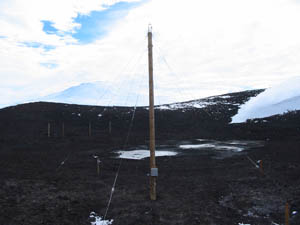
DAY 4 (Wednesday, 26 December 2012)
Met with riggers at 1:30 PM.
Took down antennas.
Measured out new VLF antennas, cut and soldered connectors. These were all day tasks
DAY 5 (Thursday, 27 December 2012)
Met with riggers at 8:30 AM, put up new antennas. This was an all-day task.
DAY 6 (Friday, 28 December 2012)
Our flight was scheduled as a backup flight. We did not know about this in advance. We were bumped. Hopefully we will fly out to South Pole tomorrow.
LESSON LEARNED: In the future, it would be good to arrange to be on a priority flight from the beginning so that our schedule is at least moderately reliable.
DAY 7 (Saturday, 29 December 2012)
We flew to South Pole and took the following shots at 90 degrees South.
South Pole
We have combined our daily notes for the South Pole portion of the trip. First, we calibrated the VLF system. Then we installed a new antenna mast and hung new VLF antennas. See picture of the completed task below. When this task was completed, we calibrated the system once more, and we were off to McMurdo.



